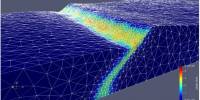A metamaterial is an artificial material with properties that are not found in naturally occurring materials. A nonlinear metamaterial is a material that has been created artificially and can exhibit properties not found in nature. These are a type of metamaterial that responds to electromagnetic waves in a nonlinear manner. This means that their behavior varies according to the intensity of the electromagnetic waves with which they interact. Its permittivity and material permeability characterize its response to electromagnetic radiation. The refractive index is the product of permittivity and permeability.
Nonlinear metamaterials, unlike natural materials, can have a negative refractive index. These materials can also exhibit a more pronounced nonlinear response than naturally occurring materials. These are a nonlinear periodic transmission medium. Because the microscopic electric field of the inclusions can be larger than the macroscopic electric field of the electromagnetic (EM) source, this is a type of negative index metamaterial with nonlinearity. This then becomes a useful tool for improving the metamaterial’s nonlinear behavior.
The response to electromagnetic waves in traditional materials is linear, which means that the output is directly proportional to the input. Nonlinear metamaterials, on the other hand, exhibit nonlinear behavior rather than being directly proportional to the input.
The hysteresis-type dependence of the material’s magnetic permeability on the magnetic component of the incident electromagnetic wave (light) propagating through the material, on the other hand, can yield a dominant nonlinear response. Furthermore, the magnetic permeability’s hysteresis-type dependence on field intensity allows the material to be switched from left to right-handed and back.
A split-ring resonator (SRR) is one type of nonlinear metamaterial. SRRs are small, artificially designed structures that can interact with electromagnetic waves in unexpected ways. They have a resonant frequency that can be tuned by adjusting their size and shape, allowing them to interact with electromagnetic waves at specific frequencies.
Application
Nonlinear metamaterials could be used in a variety of fields, including telecommunications, photonics, and optics. They can be used to make frequency converters, modulators, and detectors. They can also be used to manipulate light at the nanoscale, allowing advanced optical devices to be created.
In summary, nonlinear metamaterials are a fascinating area of research with many potential applications. They have the ability to manipulate electromagnetic waves in ways that traditional materials cannot, making them a valuable tool for researchers and engineers.
















